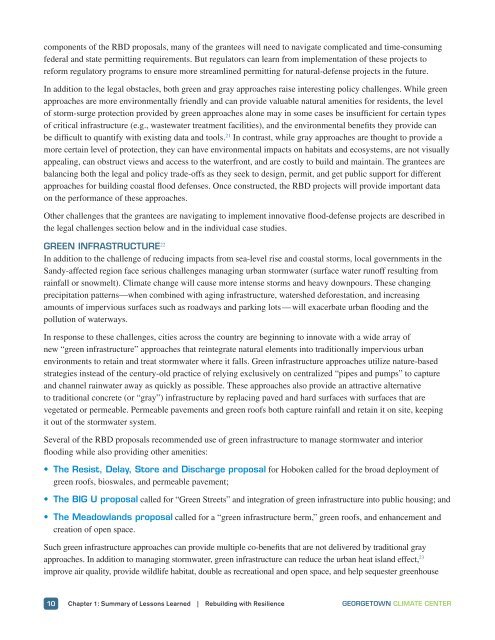Rebuilding with Resilience
dw0r306aHfX
dw0r306aHfX
You also want an ePaper? Increase the reach of your titles
YUMPU automatically turns print PDFs into web optimized ePapers that Google loves.
components of the RBD proposals, many of the grantees will need to navigate complicated and time-consuming<br />
federal and state permitting requirements. But regulators can learn from implementation of these projects to<br />
reform regulatory programs to ensure more streamlined permitting for natural-defense projects in the future.<br />
In addition to the legal obstacles, both green and gray approaches raise interesting policy challenges. While green<br />
approaches are more environmentally friendly and can provide valuable natural amenities for residents, the level<br />
of storm-surge protection provided by green approaches alone may in some cases be insufficient for certain types<br />
of critical infrastructure (e.g., wastewater treatment facilities), and the environmental benefits they provide can<br />
be difficult to quantify <strong>with</strong> existing data and tools. 21 In contrast, while gray approaches are thought to provide a<br />
more certain level of protection, they can have environmental impacts on habitats and ecosystems, are not visually<br />
appealing, can obstruct views and access to the waterfront, and are costly to build and maintain. The grantees are<br />
balancing both the legal and policy trade-offs as they seek to design, permit, and get public support for different<br />
approaches for building coastal flood defenses. Once constructed, the RBD projects will provide important data<br />
on the performance of these approaches.<br />
Other challenges that the grantees are navigating to implement innovative flood-defense projects are described in<br />
the legal challenges section below and in the individual case studies.<br />
GREEN INFRASTRUCTURE 22<br />
In addition to the challenge of reducing impacts from sea-level rise and coastal storms, local governments in the<br />
Sandy-affected region face serious challenges managing urban stormwater (surface water runoff resulting from<br />
rainfall or snowmelt). Climate change will cause more intense storms and heavy downpours. These changing<br />
precipitation patterns—when combined <strong>with</strong> aging infrastructure, watershed deforestation, and increasing<br />
amounts of impervious surfaces such as roadways and parking lots — will exacerbate urban flooding and the<br />
pollution of waterways.<br />
In response to these challenges, cities across the country are beginning to innovate <strong>with</strong> a wide array of<br />
new “green infrastructure” approaches that reintegrate natural elements into traditionally impervious urban<br />
environments to retain and treat stormwater where it falls. Green infrastructure approaches utilize nature-based<br />
strategies instead of the century-old practice of relying exclusively on centralized “pipes and pumps” to capture<br />
and channel rainwater away as quickly as possible. These approaches also provide an attractive alternative<br />
to traditional concrete (or “gray”) infrastructure by replacing paved and hard surfaces <strong>with</strong> surfaces that are<br />
vegetated or permeable. Permeable pavements and green roofs both capture rainfall and retain it on site, keeping<br />
it out of the stormwater system.<br />
Several of the RBD proposals recommended use of green infrastructure to manage stormwater and interior<br />
flooding while also providing other amenities:<br />
• The Resist, Delay, Store and Discharge proposal for Hoboken called for the broad deployment of<br />
green roofs, bioswales, and permeable pavement;<br />
• The BIG U proposal called for “Green Streets” and integration of green infrastructure into public housing; and<br />
• The Meadowlands proposal called for a “green infrastructure berm,” green roofs, and enhancement and<br />
creation of open space.<br />
Such green infrastructure approaches can provide multiple co-benefits that are not delivered by traditional gray<br />
approaches. In addition to managing stormwater, green infrastructure can reduce the urban heat island effect, 23<br />
improve air quality, provide wildlife habitat, double as recreational and open space, and help sequester greenhouse<br />
10 Chapter 1: Summary of Lessons Learned | <strong>Rebuilding</strong> <strong>with</strong> <strong>Resilience</strong> GEORGETOWN CLIMATE CENTER


